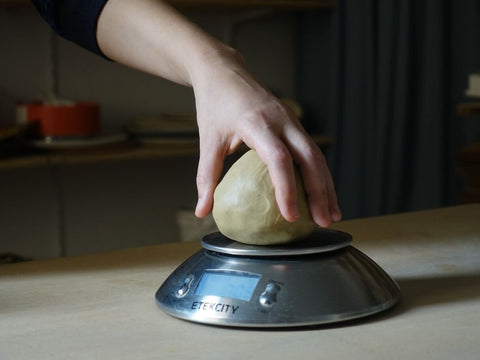Ever started a project with too little clay, only to struggle with a tiny, stubborn cylinder? Or maybe you went overboard, throwing a massive chunk on the wheel and spending half the session trimming it down?
Finding the right amount of clay is key to working efficiently and avoiding waste. Reference charts can help, but no single formula works for everyone. Your style, the form you’re making, and the type of clay all play a role. Let’s break it down.
5 key factors to consider
1. Wall thickness
The thicker the walls, the more clay you need. For a delicate cup, 3-5 mm is ideal. If you’re making a sturdy bowl or sculpture, aim for at least 1 cm.
2. Shape of the piece
A tall, narrow cylinder requires less clay than a wide, open bowl. The more curves and angles you add, the more clay you’ll need.
3. Foot height
A high foot adds to the overall clay weight, especially if you carve it rather than attach it separately. Even a small change in foot height can affect how much clay you start with.
4. Type of clay
Dense clays like stoneware are heavier, while porcelain shrinks more during drying and firing. If your clay has a high shrinkage rate, start with 10-15% more material than you would with a low-shrinkage clay body.How to estimate the right amount of clay
1. Use a reference chart as a starting point.2. Keep track of the clay you use and observe the results.
3. Adjust based on experience. There’s no fixed formula, just trial, error, and refinement.
Clay weight guide
| Oggetto | Peso (g) | Altezza (cm) | Larghezza (cm) |
|---|---|---|---|
| Tazze | |||
| Tazza da caffè 18 cl | 280 | 7.5 | 7.5 |
| Tazza da caffè 25 cl | 350 | 12 | 7.5 |
| Boccale da birra 40 cl | 600 | 18 | 9 |
| Piatti | |||
| Piattino | 370 | 2.5 | 14.0 |
| Piatto grande da cena | 1850 | 3.0 | 30 |
| Piatto medio da cena | 1360 | 2.5 | 25.5 |
| Piatto da contorno | 1000 | 2.5 | 20.5 |
| Piatto pane e burro | 600 | 1.9 | 16.5 |
| Ciotole | |||
| Ciotola grande | 2600 | 15.0 | 30.5 |
| Ciotola media | 1850 | 11.5 | 25.5 |
| Ciotola piccola | 650 | 7.5 | 15.5 |
| Ciotola grande per insalate | 1820 | 11.5 | 25.5 |
| Casseruola 4 litri | 2600 | 20.3 | 30.5 |
| Casseruola 2 litri | 1800 | 11.4 | 21.6 |
| Casseruola 1 litro | 1000 | 10.2 | 16.5 |
| Caraffe | |||
| Lattiera | 400 | 12.7 | 7.6 |
| Brocca da 50 cl | 680 | 16.5 | 10 |
| Brocca da 2 litri | 2600 | 35.5 | 15.5 |
| Teiera grande | 2000 | 20 | 20 |
| Teiera media | 1550 | 15.2 | 15 |
| Teiera piccola | 1000 | 11.5 | 13 |
| Decanter da vino 1 litro | 2000 | 30.5 | 18 |
| Decanter da vino piccolo | 1200 | 20 | 12.5 |
| Barattoli | |||
| Barattolo grande | 2250 | 30.5 | 12.5 |
| Barattolo medio | 1550 | 25.5 | 10 |
| Bottiglie | |||
| Bottiglia piccola | 680 | 15 | 9 |
| Bottiglia grande | 1100 | 21 | 11 |
There’s no universal “perfect” clay weight, just the right amount for your way of working. Use this guide as a reference and adjust it over time.
For more pottery & design content, follow Erra Ceramica.
You can also check out my work and creative process on Instagram.

